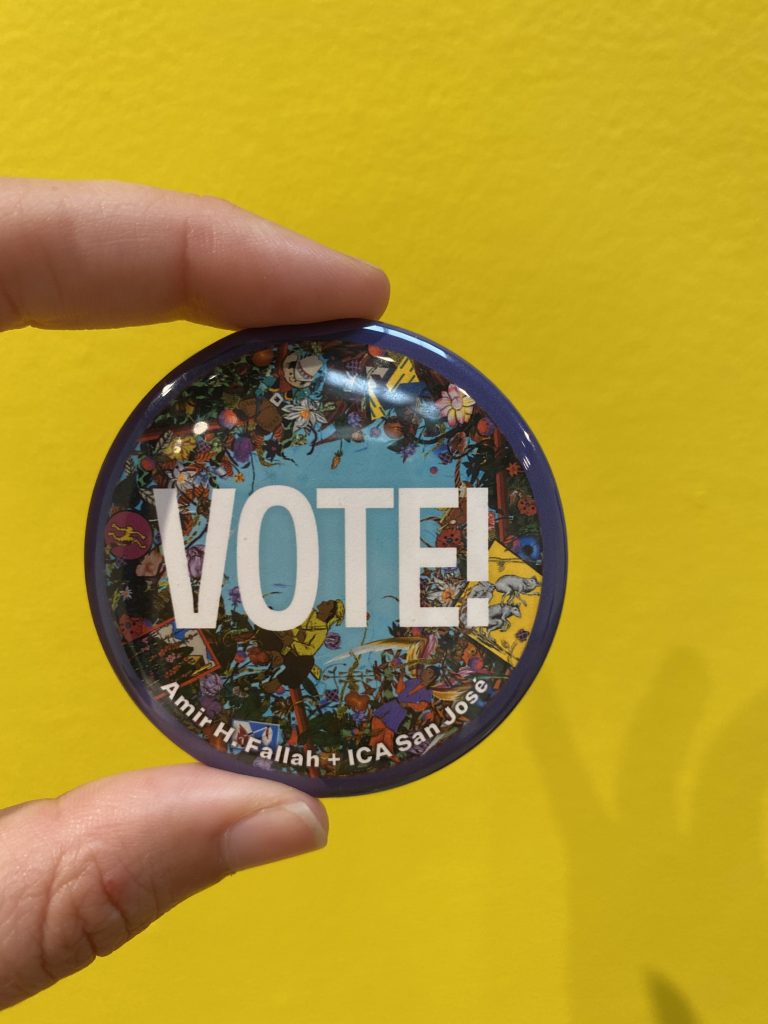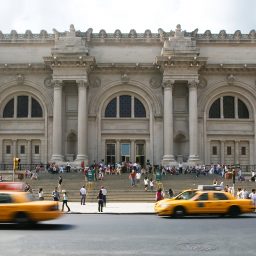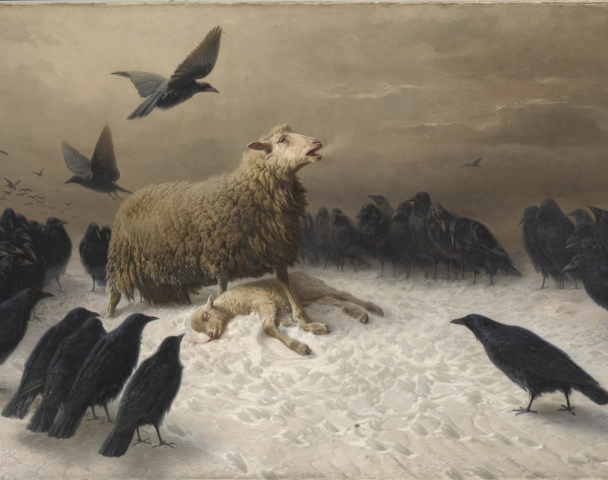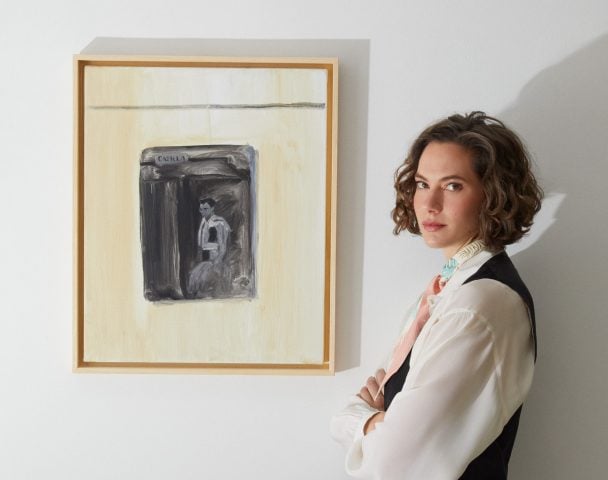The night after the first US presidential debate, I felt like I was Zooming through mud. As I looked out at the grid of anxious faces in our all-staff meeting, I admitted that I felt more interested in crawling into bed with macaroni and cheese than discussing our mundane to-do list (scheduling lighting designers for the façade, laying out a membership e-blast, selecting the perfect new Plexiglas shield for our visitor’s services desk).
But something motivated me to forge ahead. Three months ago, we made a decision that has helped me stave off despair and feel like, in some small way, we were acting for change: We decided to turn our museum into a polling place on November 3 and partner with artist Amir Fallah to generate a get-out-the-vote campaign tied to a new commission for the ICA San José.
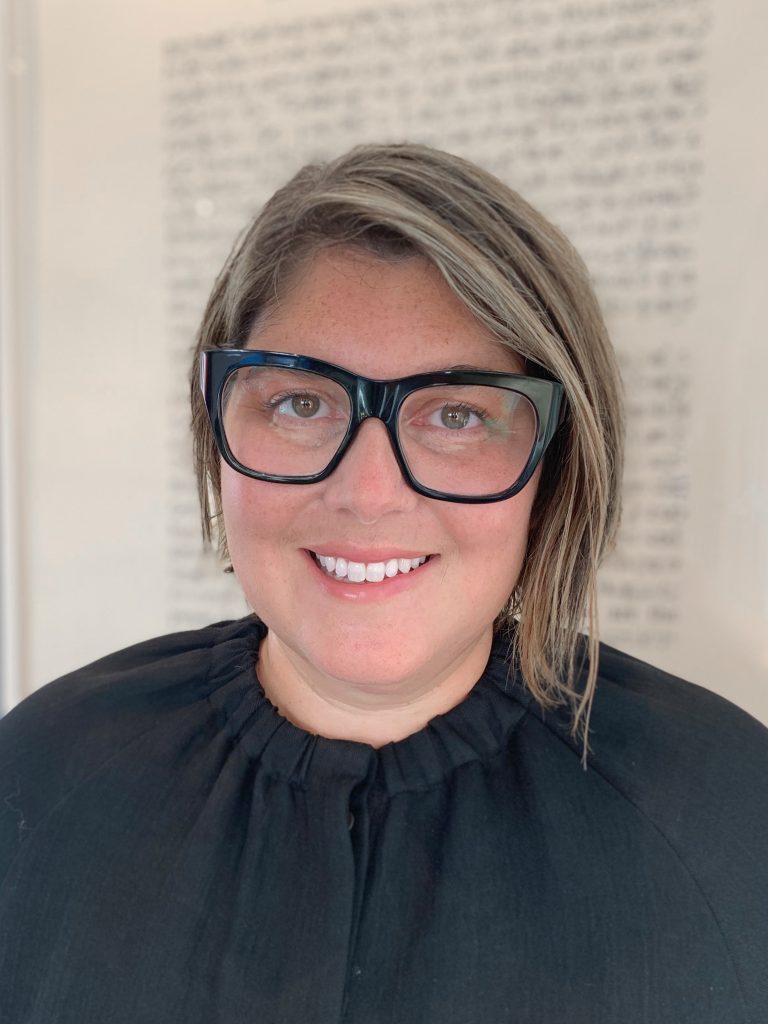
Alison Gass. Photo: ICA San José.
It was perhaps an unorthodox move just four weeks into my directorship at the ICA (a job I feel incredibly lucky to have as so many peers face furloughs, layoffs, and other unimaginable decisions around staffing). However, a confluence of events—including our 40th anniversary and the ICA’s first leadership transition in 20 years, not to mention the cultural, social, and political turbulence of 2020—put us in a position to dramatically shift course in rapid response to the moment.
Making Moves
Never before have I felt such urgency to define our institutional values as a metric system against which to make decisions. The need for arts institutions to support and appoint BIPOC artists, staff, and leadership of color and to engage and educate the broadest possible audiences is more critical than ever. The uniqueness of our programming lies in thinking about what we specifically can do in our place, in this moment quickly.
We were particularly well positioned to pivot. We are a small kunsthalle on reasonably solid financial footing. We do not rely on ticket revenue (admission is free) and are not yoked to a particular narrative of art history (we have no collection). That made it possible to undertake a hybrid commissioning project and civic action that required a near-complete dedication of public engagement, fundraising, and marketing.
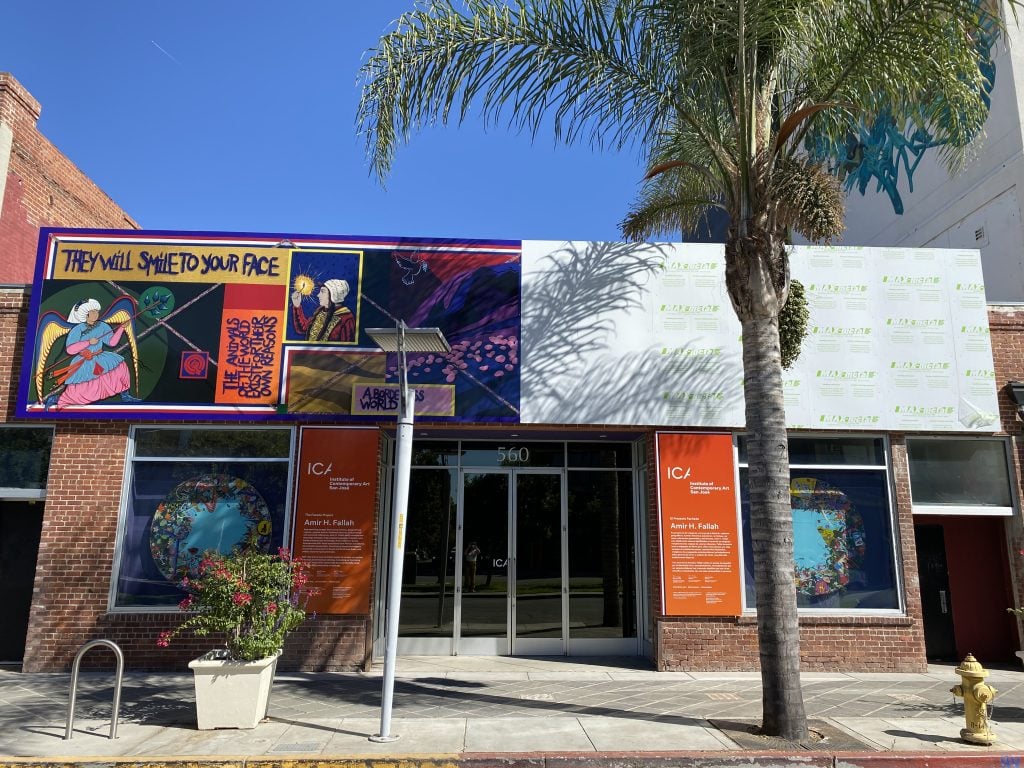
The facade of the ICA San José with work by Amir Fallah. Photo: ICA San José.
Before we opted to become a polling place, we originally conceived the project as a very different kind of museum takeover: a commission that spans our building’s facade, with the option to extend to our street-level front windows. The goal is to engage new communities (San José, the third largest city in California, is also among the most diverse in the country) but also to allow art—particularly by figures who have been unjustly pushed to the margins of mainstream art history and mainstream American art institutions—to exist in the public realm, ready to be stumbled upon and to inspire.
A Commission Is Born
Amir H. Fallah, an artist I have been thinking about off and on for a few years, immediately agreed to take on the inaugural commission. Appropriating images from across history, geography, popular and art-historical sources, and personal and universal references, Fallah points to his own navigation of his Iranian and American identity, reminding us that being American today often means one does not identify solely with any single nationality or heritage.
When I called Amir with the completely impractical idea of making three massive paintings in short order, we agreed that the piece would have to be completed ahead of and speak directly to the US Presidential election. In those early conversations, however, we weren’t thinking about dedicating the inaugural project entirely to voter initiatives. That developed through happenstance.
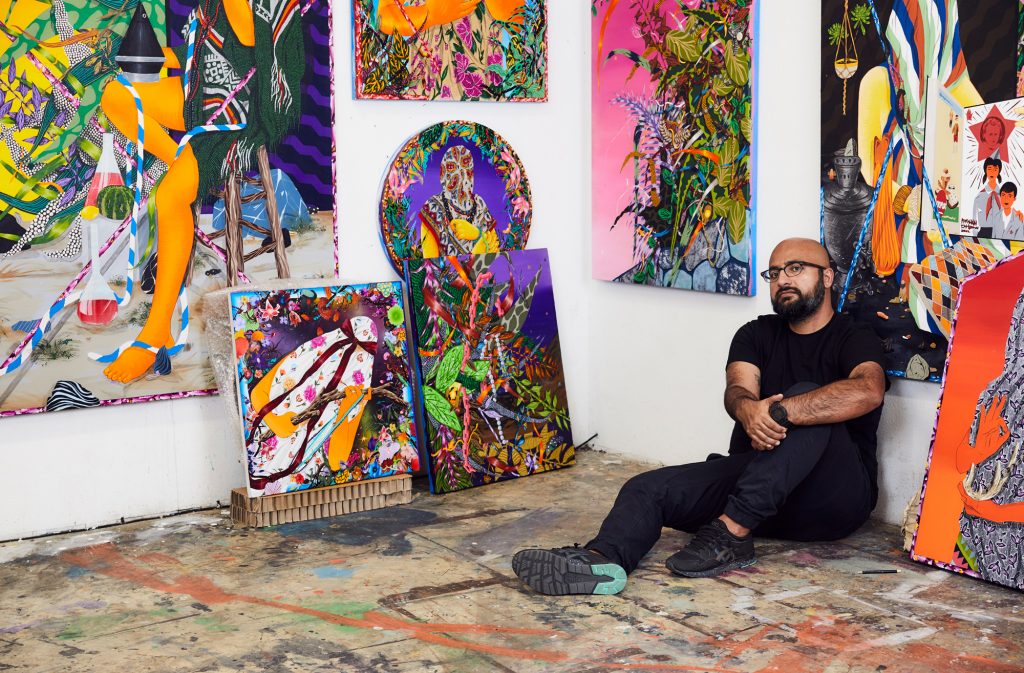
Amir H. Fallah. Photo: Courtesy of the artist and Shulamit Nazarian.
MACLA/Movimiento de Arte y Cultura Latino Americana—a hybrid urban arts space rooted in the Chicano/Latino experience down the block from the ICA—had long served as a polling place. This year, given the complications of the shutdown, they were unable to do so.
In conversation with Anjee Helstrup-Alvarez, MACLA’s director, we decided, like a number of museums and galleries across the country, to step in to serve as a vote center. This involved essentially subletting our space to the Santa Clara Elections Commission at no charge for four days and providing the staff to manage the facility while the election teams transformed the space into a polling center.
Get Out the Vote
We sought to make the mural and the vote center a fully intertwined project, working with Amir to adapt imagery from his newly made paintings for posters in plaster bus shelters in and around San José that were overlaid with Michelle Obama’s quote urging all to “vote like your life depends on it” along with voter information for Santa Clara County.
The guidelines for the advertisements, provided by the media company that manages these spaces, stated that they could not be overtly political or partisan. But we got no pushback on this phrasing, nor on this snippets of appropriated text in Fallah’s mural, including “a world without borders…” and “remember my child, nowhere is safe…”
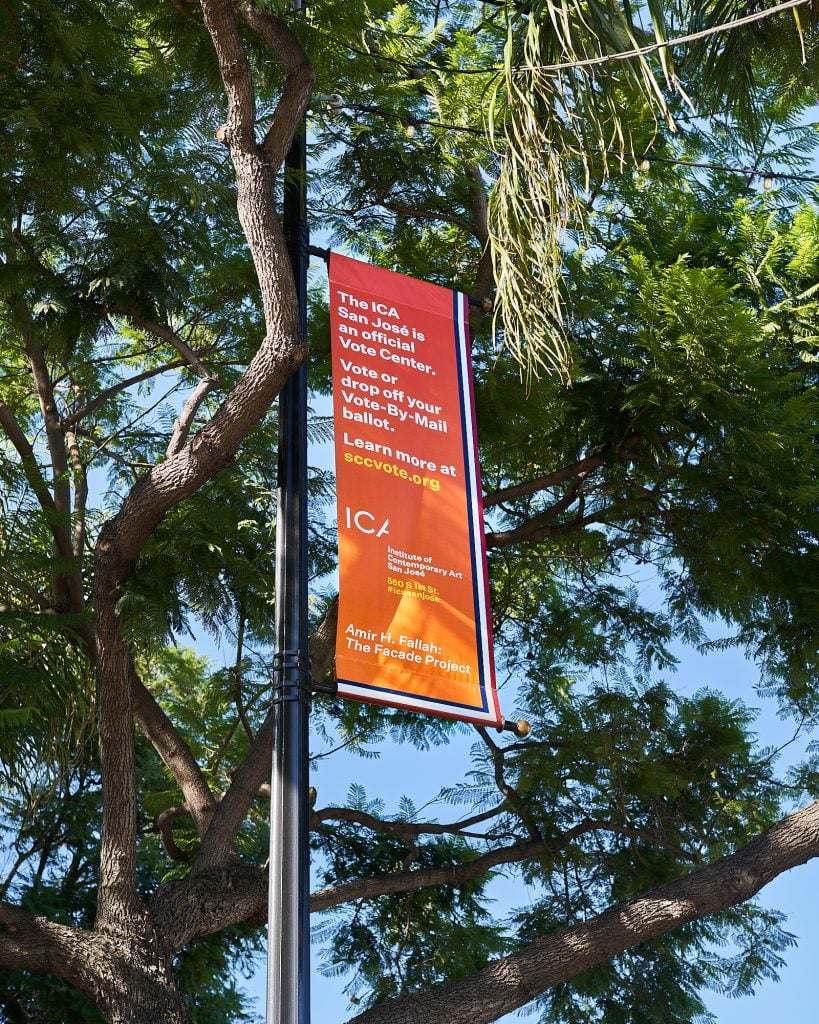
One of Amir Fallah’s Get Out the Vote banners. Photo: ICA San José.
It began to feel as if we were genuinely living the “museums are not neutral” mantra, partnering with an artist to harness our platform to make change, urge action, and engage a community in a civic responsibility that has very little to do with going to see art in a museum.
But our medium for this message is still the artist’s work. The collaboration highlights the inextricable ties between the political world and the contemporary museum space—something that may represent a revised or refined mission for the ICA San José moving forward.
A Fertile Moment
I’m not the only one seizing this moment to reevaluate our fundamental way of working. Anjee Helstrup-Alvarez at MACLA and a group of other thought leaders recently formed the platform the Cultural New Deal, which urges cultural leaders to consider that “the main question that we all confront now is whether we will emerge from this era choosing to maintain the same systems and beliefs that support the current culture of division and death or if we will instead move forward toward a more just, shared future, guided by world views that foster collaboration and mutuality.”
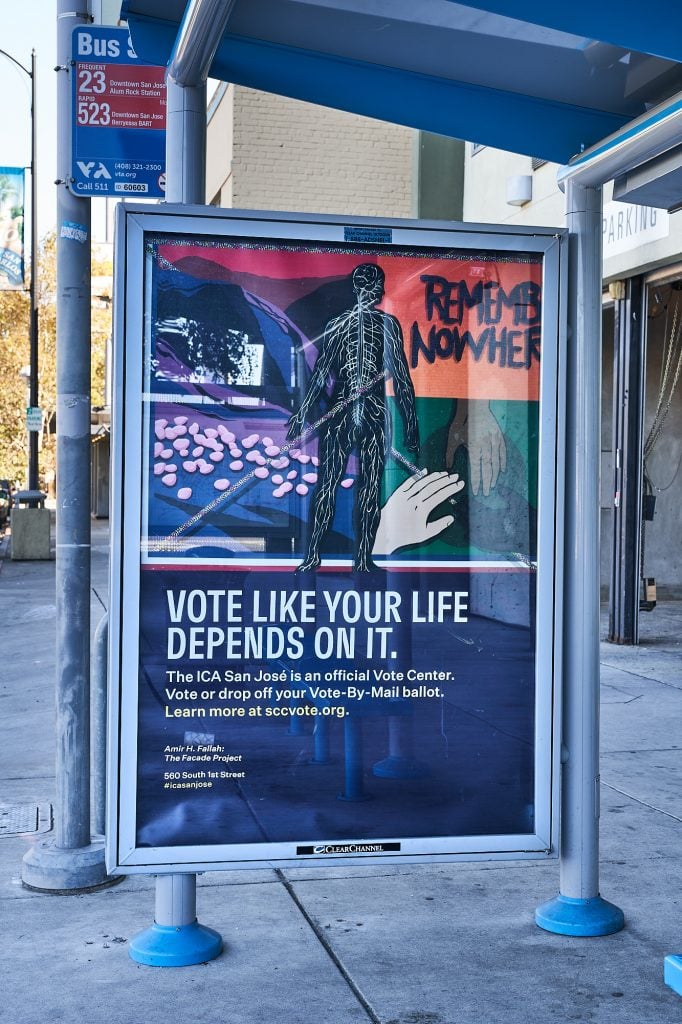
One of Amir Fallah’s bus shelters. Photo: ICA San José.
Perhaps this is a moment when tiny, nimble arts organizations like ours can capitalize on the ease of steering a small ship to navigate toward larger-scale change. Indeed, the combination of the facade project and the vote center might form the seed of a new way of defining what an ICA in a large urban center might be. We are certainly not going to formally revise the mission of the ICA in a few months—but we can internalize the experience as a roadmap for the future. We can dedicate our marketing dollars, our physical space, and our staff energies to engaging the issues that we agree are most urgent.
For now, the most urgent issue is getting out the vote. I’m hoping people will follow Michelle Obama and Amir Fallah and the many others who are urging them to do so—because their lives depend on it.
Alison Gass is the director of the San José Institute of Contemporary Art.
